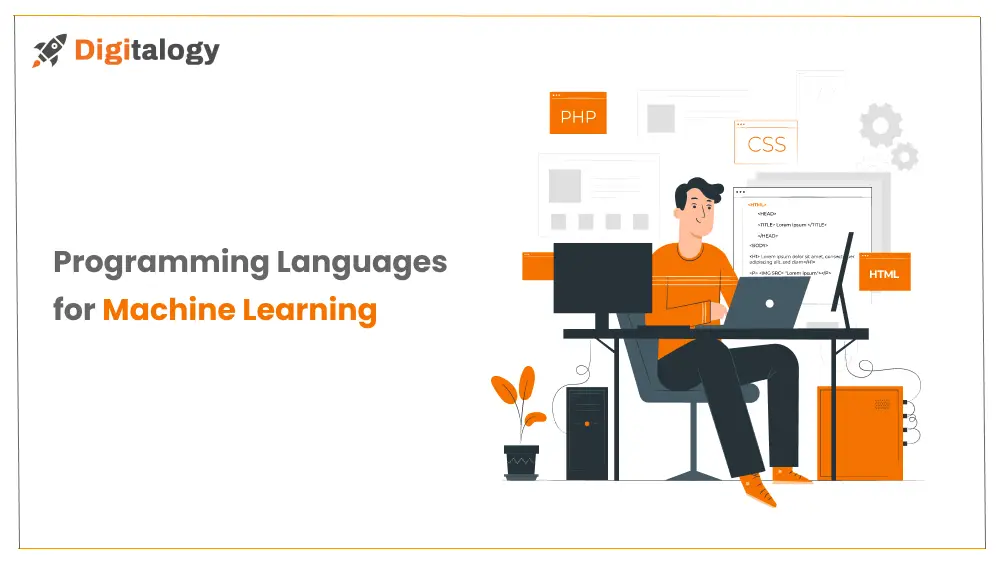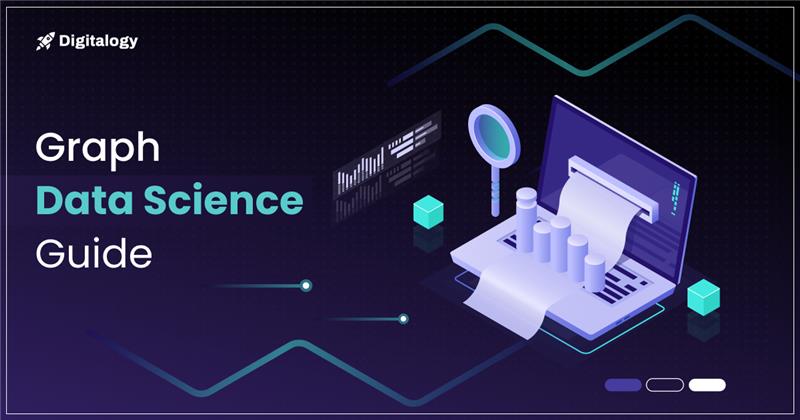To benefit from the field of machine learning, it is essential to master the programming languages that are required for it. We must understand some of their fundamental concepts and how they apply. The focus of this article will be to mention the best programming languages for machine learning.
The domain of machine learning is one that is being heavily used. A machine must be trained, which is a tough challenge. It presents its difficulties. The ability to communicate with a machine is the initial and most essential requirement. We must understand the syntax of any machine or computer in order to communicate with it, and machine learning isn’t any different.
What is Machine Learning?
A subfield of AI technology called machine learning uses mathematical properties to build robust, precise, and durable computerized models. It uses statistical methods and algorithms to give computers the ability to carry out particular jobs and get better at them over time, all on their own, without help from humans.

There are no difficult rules that specify these concepts. The computer uses previous data to detect connections and patterns and then uses those patterns to autonomously forecast fresh data.
Machine learning is a branch of AI, whereas deep learning is a branch of machine learning. Although they may all appear to be alike, they are not.
Uses of Machine Learning
- Stock market algorithms: Recurrent neural networks (RNN) and Long Short Term Memory (LSTM) are examples. The algorithms are adjusted for the variables when improving the trade methods while taking into account the rise and fall in stock markets.
- Traffic Prediction: If you’re traveling to a new location, Google Maps is your buddy while taking the leased traveled route. By taking into account the average duration of days in the past while also considering the duration and the real-time geolocation of the car from the map applications and sensors, it anticipates traffic scenarios like congestion and delayed moving or uncluttered routes.
- Voice Recognition: One of the most well-known applications of machine learning is the recognition of voices by machines, which has transformed the way homes look. Voice recognition entails the conversion of spoken instructions. Voice recognition or “Speech to text” are common terms used to describe this. There are several different assistants, including Apple’s Siri, Microsoft’s Cortana, Google Home Speakers, Amazon’s Alexa, and Google Assistant.
These are the few uses of machine learning. The list is very wide as machine learning has evolved over the years.
Best Programming Languages for Machine Learning

1. Python
Python Programming Language is a very popular and broadly used language for machine learning. It was created by Guido Van Rossum in 1991. Python is a robust, interacting, multi-paradigm, coding, programming language that is available as open-source software.
It is simple to operate, the language is accessible, and the English syntax is simple to understand. Its flexibility is how it operates. Python differs from its competitors since it does not call for storing a code and executing it later. The modules or packages can be imported to simply reuse the codes.
Python is accessible, explicable, and flexible. It comes with a variety of built-in components, libraries, and tools. It can be used on any operating platform, like Windows, Linux, UNIX, and Macintosh.
Python is widely employed to address challenges in all areas of machine learning. Additionally, SQL integration is possible. It may be used to develop web apps utilizing Flask for model deployment, perform data analysis, wrangling, visualize data, build models, and build pipelines. It offers numerous deep learning and machine learning algorithms.
2. R
R programming language is the language that data scientists use for machine learning. This language focused on statistical computation and visualization of data. The command prompt and other IDE (Integrated Development Environments) are supported.
It includes APIs that let users interact with TensorFlow and is simple to code. It includes a terminal, editors for syntax highlighting, and a number of tools for controlling libraries and graphing. R is a generative functional language that was created specifically for big statistics and data presentation.
R allows for quick development, operates with huge datasets, and also is useful for deep analysis for creating machine learning algorithms. This flexible, array-based language is compatible with a number of OS, including Windows, Linux, and OS X.
3. Java
Java is renowned for back-end systems and huge company development. It provides settings for carrying out different machine-learning operations with visual user interfaces. The Java Virtual Machine (JVM) enables programmers to create code that is consistent across several platforms. Java apps may be created quickly and are flexible.
Fink, Hadoop, Hive, and Spark are a few of the well-known data science frameworks that were created in Java. Java is the language used in the operational codebases. Because so much software, infrastructure, and business use Java, integration, collaboration, and coordination are also less of a worry.
Java is helpful for many different data science procedures, including data cleansing, data export and import, data analysis, deep learning, natural language processing, and data visualization.
4. C++
C++ provides a number of benefits despite not being a first choice of programming language for machine learning. C++ is effective, provides a degree of control – it enables the controlling of storage and individual resources like the CPU – and also can modify algorithms. It also has a number of libraries, including:
- Tensorflow: It is a Google open-source framework that includes tools for managing libraries, troubleshooting, scaling, debugging, and pipelining as well as computational and information flow graphs. Numerous numerical computations can be done with TensorFlow.
- Microsoft Cognitive Toolkit: This open-source framework uses directed graphs to visualize networks and carry out calculations, making it ideal for deep learning and big data.
- Caffe: Caffe is a deep-learning platform that boosts efficiency and enables operations with creative design and extendable code.
- Mlpack: Mlpack is an adaptable platform for machine learning. Durability, efficiency, and ease of use are its main concerns.
- Shogun: Shogun is an accessible library that offers a number of tools. It uses a variety of machine learning techniques, covering numerous data formats, classes of algorithms, and all-purpose tools.
5. Julia
Julia is an open-source and versatile dynamic programming language. Due to its simple syntax, it is appreciated among programmers and is both practical and object-oriented. It is simple and approachable.
High-performance quantitative simulation and statistical analytics can benefit from this scripting language. It is useful for machine learning since it features a sizable quantitative functional library that offers fundamental math and scientific inquiries.
It can be swiftly installed in huge groups, is extremely scalable, and works well for machine learning. On all the well-known clouds, it is enabled for both TPU and GPU. Along with supporting editors like Emacs and VIM, Julia furthermore supports IDE (integrated development environments) like Visual Studio and Juno.
Because Julia’s script can be executed by all computers, it can be inherently gathered from several other languages, including Python or R, utilizing PyCall or RCall, and then run inside a machine learning program. The low-level virtual machine (LLVM) model enables the compiling of its code just before use or in time.
6. Scala
The multi-support programming language, Scala, a scalable language is well-known. It is a strong programming language that incorporates both fully functioning and object-oriented development tools. Each item acts as an object, much like Python, which is another object-oriented programming language.
The strongly typed programming language Scala assists complex applications and stays free of bugs. It was originally developed for the Java Virtual Machine (JVM), and the JVM executes the bytecode generated from its code base.
The following are a few of the well-known Scala libraries that are designed for the creation of processes and apps like computer science, linear programming, and random number creation:
- Saddle
- Aerosol
- Breeze
- Scalalab
- NLP
Through features like advanced data aligning, 2D data formats, and autonomous data orientation, these libraries are helpful for manipulating data.
The main feature of Scala is that this language was created to cope with business apps that have enormous datasets with plenty of data and need scalability. It is used for many different things, such as creating simple scripts to organize massive systems of data processing.
7. LISP
John McCarthy, a software engineer and computer scientist from the United States, created List Processing (LISP) in 1958. It is among the oldest programming languages and one that is specifically geared toward artificial intelligence is widely used.
The development of several well-known machine learning programming languages, like Python, Julia, and Java, began with this written computer language LISP. Because it is so versatile and rapid at experimenting, LISP makes it simple to create reactive objects.
Along with functionality for symbolic patterns, it offers automatic trash pickup. Inductive logic issues and machine learning are two areas where it is particularly helpful.
With the ability to compile, run, and embed code in more than 30 programming languages, LISP has the characteristics of a domain-specific language. operates using the Read-Eval-Print-Loop (REPL).
Conclusion
This blog has examined the value of programming within the context of machine learning. While there isn’t a particular “optimal” language to learn, we’ve discovered that certain languages are better suited than others to perform machine learning tasks.
Here we have provided a detailed description of every programming language that is suitable for machine learning. However, before picking the right language you should understand the algorithm of your project and what are its needs. On the basis of this, you can pick a programming language that has the tools and libraries according to your choice.
Machine Learning is an interesting path. If you wish to learn more about it and have a career in machine learning. There are many courses which you can opt to polish your knowledge.
FAQs
Ans. There are many languages that are well-suited for machine learning, such as Python, Java, R, C++, etc.
Ans. If we compare C++ to other languages, it is a very smooth and easily operable language. Which makes it easy to use and employ for machine learning.
Ans. Yes, developers are in high demand these days so coding is relatively a great career option.







